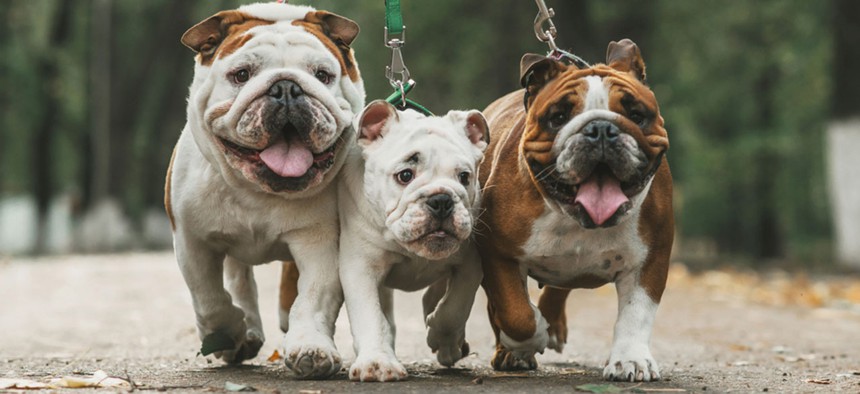
Runa Kazakova/Shutterstock.com
Body Language You Should Borrow From Your Dog and Use On Your Boss
Observing how your pets play can offer a lesson in the importance of clear communication.
There are a lot of lessons we can learn from the animal kingdom, and how to negotiate may be the most important of them all.
Just like humans, animal species engage in constant communication and negotiation. Monkeys groom one another to cement bonding. Wolf packs share a fresh kill according to hierarchy. Each movement, posture, and vocalization in the among animals is part of a rich and deeply-ingrained social structure. Even observing how your pets play can offer a lesson in the importance of clear communication.
Telegraph your intentions
The play behavior of dogs offers one of the best examples of successful negotiation, according to Marc Bekoff, a professor emeritus of ecology and evolutionary biology at the University of Colorado at Boulder.
“When animals play, they typically perform behavior patterns that are used in other contexts, such as predation, aggression, or reproduction,” says Bekoff, who specializes in the study of dogs, wolves, coyotes, and related animals. In order to negotiate play, animals must constantly reassess their relationships even as they are actively engaged with one another.
Bekoff calls this behavior “fine tuning on the run.” And he says there are a lot of parallels with human negotiations, in which one person must read their counterpart correctly and modify their behavior accordingly, in order to get what they want.
In animals, the “play bow” of canines, raccoons, bears, and many others is a particularly telling negotiation behavior, in part because it’s extremely easy to identify. Animals “stick their butts up in the air, wag their tails, and sometimes bark,” Bekoff says. “The bow is ‘play soliciting signal.’ It tells the recipient, ‘I want to play with you, I don’t want to fight with you or eat you.’”
This communication of intent to play is similar to the first rule of sales negotiation in Harvard Business School’s program on negotiation: “Clarify your interests.” Though humans won’t get down on all fours and wiggle their rumps in a business meeting to see who wants to sign a contract, being clear from the outset about what’s about to take place is helpful for everyone. This creates a fair foundation for the negotiation.
Play by the rules
For animals, playing fairly can be a matter of life or death. “Animals predominantly behave fairly,” Bekoff says. “Although it doesn’t always look like it, and a snapshot doesn’t always capture it, if you look at the whole interaction you see: If you don’t play fair, we don’t play at all.”
To illustrate, Bekoff points to his research on what happens to individual coyotes and yellow-bellied marmots that don’t follow the “rules” of play. If an animal continues to mount others or play rough, even when play partners become aggressive in an attempt to fend them off, individuals “have to leave the group and suffer four times higher mortality rates,” Bekoff says.
That’s a pretty serious repercussion for a seemingly small deviation. But it shows how important it is to play by the rules during a negotiation, particularly given small-group dynamics. Business meetings that fall apart when one party behaves badly probably won’t culminate in exile. But negotiators may find that their potential partners are unwilling to do business with them in the future—and that they spread the word to other contacts to steer clear.
Check in with your opponent
The play bow does a lot more than establish the tone of the interaction. It’s also used to apologize, reassure, and clarify good intentions after animals get too rough. In other words, the play bow provides a way for dogs and other animals to consistently check in with one another. The importance of this approach is emphasized in Harvard’s negotiation advice to ask questions. “Your goal is to understand the other party’s interests as well as possible,” one article on negotiation skills instructs.
Bekoff also says that animals can teach humans a lot about the importance of picking up on body language and other nonverbal cues.
“Pay attention: if someone’s sitting across the table with their arms crossed, they’re shut down,” he says. “Same with a dog with its tail tucked, ears back. You can know what he or she is going to do.” Being able to understand the physical presentation of your negotiation partner—human or otherwise—can help you understand how to proceed next.
We all have the same goal: Whether you’re a wolf of Yellowstone or a wolf of Wall Street, you don’t want to get bitten.






